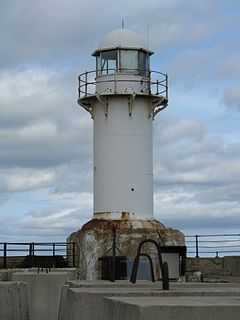South Gare Lighthouse
 | |
| South Gare lighthouse | |
| Location | South Gare, Redcar |
|---|---|
| Coordinates | 54°38′51″N 1°08′15″W / 54.647413°N 1.137455°W |
| Year first constructed | 1884 |
| Year first lit | 1884 |
| Automated | Yes |
| Foundation | concrete |
| Construction | stone and cast iron |
| Tower shape | cylindrical |
| Height | 43 feet (13 m) |
| Focal height | 53 feet (16 m) |
| Original lens | 4th order 12 panel glass prismatic |
| Current lens | original |
| Light source | 35 Watt CDM-T lamp |
| Intensity | 150,000 Candelas |
| Range | White 20 miles (32 km) Red 17 miles (27 km) |
| Characteristic | 0.5s flash every 12s |
| Fog signal | removed |
| Racon | G0SBN/P |
| Admiralty number | A2626 |
| NGA number | 2020 |
| ARLHS number | ENG-131 |
| England number | |
| Heritage | Grade II listed building |
South Gare Lighthouse was built in 1884 on South Gare north west of Redcar.[1]
History
There already were two navigation light towers built in 1829 and operating in Durham county at Seaton Carew and another at Hartlepool to guide ships clear of Coatham Rocks off Redcar and then onto the Fairway Buoy outside the bar of the river Tees. The building of South Gare lighthouse was planned and supervised by John Fowler, engineer to the Tees Conservancy Commissioners.[2] Both light systems were used until 1892 when use of the light towers at Seaton Carew was discontinued by the Tees Conservancy Commissioners.[3]
The South Gare lighthouse light was originally lit by a paraffin wick lamp.[4] and perhaps subsequently by a pressurised paraffin burner.[2] This was removed in 1955, and in about 1980 the chimney and weather vane were removed.[2] The paraffin lamp was replaced by a mains powered 500 Watt tungsten filament Incandescent light bulb with a backup bulb on the bulb changer which operated with a backup diesel generator.[2] The light operated with a flash of 1.5s every 12s.[4] The lens rotation mechanism was originally powered by a clockwork motor but this was replaced by two electric motors, i.e. one duty motor and a backup motor.[2] A fog signal was mounted to the west of the lighthouse but this has evidently been removed.
Description
The lighthouse is 43 feet (13 m) high with a cylindrical cast iron clad stone tower all painted white.[4][5][6] Small porthole windows in the north and south side of the column light an internal helical newel staircase.[2]
The light source is held in an eight windowed lantern housing under a hemispherical copper domed roof. Below the windows there is a railed circular platform supported by brackets.[2] The light is a 35 Watt CDM-T lamp with a fourth order prismatic lens and can be seen for a range of 20 miles (17 nmi).[4][7] Set 53 feet (16 m) above mean high water[1] the light operates automatically exhibiting sectored red and white with a 0.5 s flash every 12 seconds with an effective intensity of 150,000 Candelas.[4] The light is powered by a Schlunk 100 Watt water-cooled hydrogen fuel cell[1][8] a world first, and an arrangement that is more reliable than the mains electricity supply along the exposed breakwater which is vulnerable in storms.
The lighthouse is a listed building[5] and still operates using the original lenses.[2] Today the lighthouse is owned and operated by PD Ports, and has the Admiralty code A2626, NGA code 2020, and Amateur Radio Lighthouse Society (ARLHS) code ENG-131.[6] The lighthouse can give status broadcasts using radio telemetry with the callsign G0SBN/P.[4][9]
References
- ↑ 1.0 1.1 1.2 Dolphin, Debbie. "South Gare Lighthouse Hydrogen Fuel Cell Beams Brightly". New England Lighthouse Treasures. Retrieved 11 July 2012.
- ↑ 2.0 2.1 2.2 2.3 2.4 2.5 2.6 2.7 "South Gare Lighthouse". Images of England. Retrieved 3 September 2013.
- ↑ "The London Gazette, 19 July 1892" (PDF). london-gazette.co.uk. Retrieved 15 January 2012.
- ↑ 4.0 4.1 4.2 4.3 4.4 4.5 "South Gare Lighthouse" (PDF). pelangi.co.uk. Retrieved 13 August 2010.
- ↑ 5.0 5.1 "South Gare Lighthouse". British Listed Buildings. Retrieved 17 August 2010.
- ↑ 6.0 6.1 Rowlett, Russ (4 August 2009). "Lighthouses of Northeastern England". The Lighthouses Directory. University of North Carolina. Retrieved 28 December 2009.
- ↑ "Hydrogen hails shipping". The Engineer. 20 November 2007. Retrieved 28 December 2009.
- ↑ Johnston, James (5 November 2007). "Teesside world first in fuel cells". Gazette Live. Retrieved 3 January 2010.; "Hydrogen power lights up the seas". New Scientist. 6 November 2007. Retrieved 27 December 2009.; "Fuel cells power lighthouses". Platinum Today. 2 November 2007. Retrieved 3 September 2013.
- ↑ "South Gare Light – ARLHS ENG-131". Amateur Radio Lighthouse Society. Retrieved 27 December 2009.
See also
Further reading
- Images of England
- British Listed Buildings
- Pelangi
- Amateur Radio Lighthouse Society
- Lighthouse E-clips
- Redcar.org.
Navigation
| |||||
| ||||||||||||||